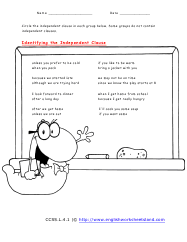Independent and Dependent Clause Worksheets
Related ELA Standard: L.4.1

A clause is a pack of words that contains a verb. This is usually a component of sentence, which is a complete thought. Clauses by themselves are not complete thoughts. Sentences are a mixed bag of independent and dependent clauses. The independent clause can in some cases make up an entire sentence. Dependent clauses are used to spice up our language, but they do not have the ability to stand on their own. They are a group of words that when used effectively can make these more creative and enjoyable for the reader. This unique collection of worksheets really takes us through just about everything you can do with this topic including basic clause identification and more importantly re-writes. Understanding how to use these in your writing can really help improve your writing. This should help you become a more effective grammar ninja!
Independent and Dependent Clause Worksheets:
What's A Clause?
- What words form an independent clause? The key at the top is something you want to make sure as a reference for the entire worksheet.
Writing Your Own Clauses
- This is where students might need a topic to promote them. This requires students to fully understand this skill.
Can You See Em'?
- Which clause is present in each sentence? Look for completely thought out sentences, that is a great way to approach this.
That Depends!
- Read the passage below and underline all of the dependent clauses
that you can find.
Do You Know?
- See what you can put together here. This a nice activity to do as a class. It can also serve as a cool poster for the class walls.
Split Them Up!
- Each phrase below needs to be split in to independent clauses
and dependent clauses. You will use a series of symbols and fill in a bunch of missing commas.
Compound Sentences
- Can you create complex sentences? Take these phrases and create one sentence
by adding joining words and commas. You can reword the phrase but do not change
the meaning.
Correct It!
- Each sentence contains an independent clause
and a dependent clause. Write the correct phrase
on each line.
It's A Zoo Out There
- Read the passage below and underline all of the independent clauses. Shade the dependent clauses.
Create Your Own
- Create your own sentences that contain one independent clause and one dependent clause.
ID the I and the D. - Write an (I) if the sentence is an independent clause. Write a (D) if the sentence is a dependent clause.
Mark It Up!
- Read the passage below and underline all of the independent clauses. Shade the joining words and mark the dependent clauses with ( ).
How to Identify the Independent and Dependent Clause
There are a series of steps you can go through to determine this. The first step is to look for a complete thought. Complete thoughts are partial to independent clauses; they do not need anything else. They also contain a subject and an action or the presence of an implied action.
Dependent clauses are rather scattered. Beside the lack of a complete thought, you will almost always see marker words (Although, whenever, while, etc.) that lead the sentence off in a different direction. Dependent clauses often contain conjunctions, but be careful because independent clauses often contain conjunction. Dependent clauses also must have a partner clause with it. Otherwise, you would have a fragmented sentence.
When you are working with two clauses the most frequent error is the overuse of commas. Commas should be used to separate two independent clauses in the same sentence. If the comma is not used it forms a fused sentence, these can be fixed with the help of a simple punctuation mark. Commas should not be used to separate dependent and independent clauses.
Why Does Any of This Matter?
We have just examined two of the four different types of clauses there are. They are the building blocks of sentences and thus have a great deal of impact on forming sentences grammatically and mechanically properly. When we first begin to write, we tend to focus on a single way to develop our sentences. This results in a narrow framework for our audience. When we begin to learn how to latch these clauses together in different and unique patterns our writing becomes more robust and it heightens our readers attention to our work because they are on the edge of their seats waiting for what comes next.

